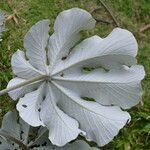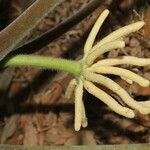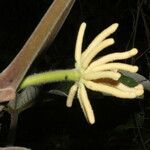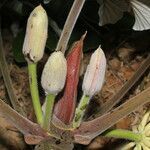Trees 6-20 m. tall with stout, seldom-branching trunks, the young branches stout, hispidulous to glabrate. Mature leaves divided about midway to the center or scarcely beyond, scabridulous above, paler and densely arachnoid-villosulose to glabrate beneath, the lobes usually 9-11, not contracted toward the base or scarcely so, obtuse to rounded at the tip, the petioles densely and minutely hirtellous, with a ferruginous-velutinous basal pulvinus; stipules about 6-9 cm. long, hirtellous. Staminate spadices in clusters of 12-30, 3-5 cm. long, about 4 mm. in diameter, with slender hirtellous stipes about 3-5 mm. long, the spathes 4-6 cm. long shortly before anthesis, broadly conic-oblongoid, densely white-arachnoid-villous, the common peduncle 7-10 cm. long after anthesis, slender, minutely hirtellous. Pistillate spadices in clusters of 4-6, at anthesis about 4-5 cm. long and 5 mm. in diameter, in fruit about 5-10 cm. long and 1 cm. in diameter, subsessile or with very inconspicuous stipes, the spathes as in the staminate inflorescences, the common peduncle about 7-8 cm. long at anthesis, somewhat accrescent in fruit.
Tree to c. 20 m high, with stilt-roots; stems with distinct leaf scars and hollow internodes; branchlets hispidulous. Leaves: lamina c. (10–) 20–60 cm diam., (7–) 8–12-lobed, upper surface scabrous, lower surface pale, minutely pubescent; lobes oblong or elliptic, entire, apex short-acuminate to rounded; lateral venation marginally loop-connected, usually branched; petiole (10–) 20–50 cm long, puberulous to pubescent, basally with a mass of glandular trichomes; stipules 3–10 (–15) cm long, bifurcate, stigose, turning reddish or brown before abscission. Inflorescence erect to pendulous, peduncles mostly 2–12 cm long; spathe 2.5–7 cm long, puberulous to pubescent. Male flowers in spikes 0.5–6 cm long, mostly in clusters of 15–25; perianth 1–1.5 mm long, pubescent near apex. Female flowers basally connate, in spikes 1–4 cm long, elongating to 9 cm long in fruit, in clusters of 2–4; perianth 1–1.5 mm long, pubescent near apex; stigma peltate. Achene ovoid to ellipsoid, c. 2+ mm long, brown, tuberculate. [See also Zich et al. (2020).]
A medium sized evergreen tree. It can grow 15-20 m high. The trunk can be 50 cm across. The trunk and branches are hollow. The leaves are large and have 7-9 lobes arranged like fingers on a hand. The leaves have lobes which are shield shaped. The leaves are downy underneath and shiny on top. The leaves can be 60 cm across. The flowers are pale yellow and showy. They are in fingered clusters on long stems. They are sweet and edible. The fruit is cylindrical, hollow with soft sweet flesh. They are 12 cm long. They are edible. There are many small seeds.








